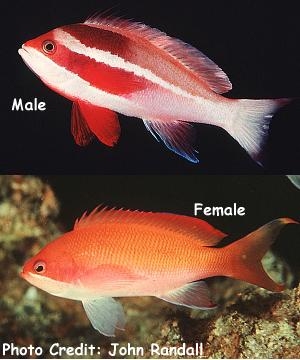
By Bob Goemans


Likely Reef Tank Suitable
Likely Fish-Only Tank Suitable
These fishes belong in the Order Perciformes and placed in the Suborder Percoidei as members of the Family Serranidae (Groupers & Anthias) which then contains the Subfamily Anthiinae. It consists of 20 genera with about 170 species, which are mostly small, peaceful, and beautiful, yet somewhat difficult to maintain. They colonize the reefs in tropical seas in large numbers and are mainly zooplankton feeders. Anthias mostly inhabit reef faces and slopes/drop-off areas at various depths and are mostly found in a temperature range of 72 - 80F (22 - 27C). Since they associate closely with the reef structure, the aquarium should have ample rock structures and hiding places so as to reduce their stress level.
They require exceptional water quality and good water movement and are schoolers in nature, therefore, it may be better to keep them in small groups in the aquarium. Yet, mixing different species in a small aquarium can cause serious disposition problems, which may lead to fighting, injury or death.
Anthias
All members of this genus are located in the Atlantic Ocean or the Mediterranean. These cooler water rocky reef species rarely make it into the trade.
Hemanthias
These are generally termed Streamer bass, and are all found in the Atlantic Ocean. All live in deep waters, usually over 200 feet (60 m). Rarely ever collected, yet sometimes they turn up from food ships trawling the areas and are turned over to collectors if still viable. Generally not suited for aquarists as their deepwater environment makes them difficult, if not impossible to maintain.
Luzonichthys
These elongated Anthias are called Splitfin Anthias and there are about six identified species, however, have little value as aquarium specimens. They are zooplankton feeders and form large shoals that inhabit current swept drop-off areas. Male and female do not differ in coloration.
Nemanthias
Often referred to as the Threadfin Anthias this one species of interest differs from the very similar Pseudanthias members because it has one more dorsal spine - eleven rather than ten. Like other Anthias it is a zooplankton feeder.
Odontanthias
These are deep water anthias, often found at depths below 200 feet (60 m). They feed solely on zooplankton, are accustom to dimly lit areas, are quite shy, and spend lot of their time hiding or exploring caves and rock crevices for prey. When available, they need a dimly lit environment having much live rock.
Plectranthias
Referred to as Perchlets, these mostly small fish come from deep areas. There are about 40 known species, with all but one coming from the Indo-Pacific area. That remaining species, P. garrupleus, hails from the Atlantic Ocean. Most are secretive and the species in this genus are rarely ever seen in the trade. However, P. inermis occasionally shows up and looks somewhat like a Hawkfish.
Pseudanthias
By far the most common of the Anthias family and generally referred to as Fairly Basslets or just plain Anthias. There is about 30 species of interest to aquarists in this genus, some of which have yet to be steadily collected for aquariums. Most are described here.
Serranocirrhitus
Originally placed in the Hawkfish family, it was later moved to the Anthias family. They differ from their cousins as they have very deep bodies and elongated fins that extend back as far as the anal fin. The shape of their eye and mouth are also somewhat different, as they present a menacing look. They also swim upside down under overhangs and in caves.
For in-depth information concerning these beautiful reef fishes, checkout Reef Fishes Volume 1 by Scott Michael (ISBN #1-890087-21-1). You can see a review of this exquisite book by visiting my Product & Book Reviews page.